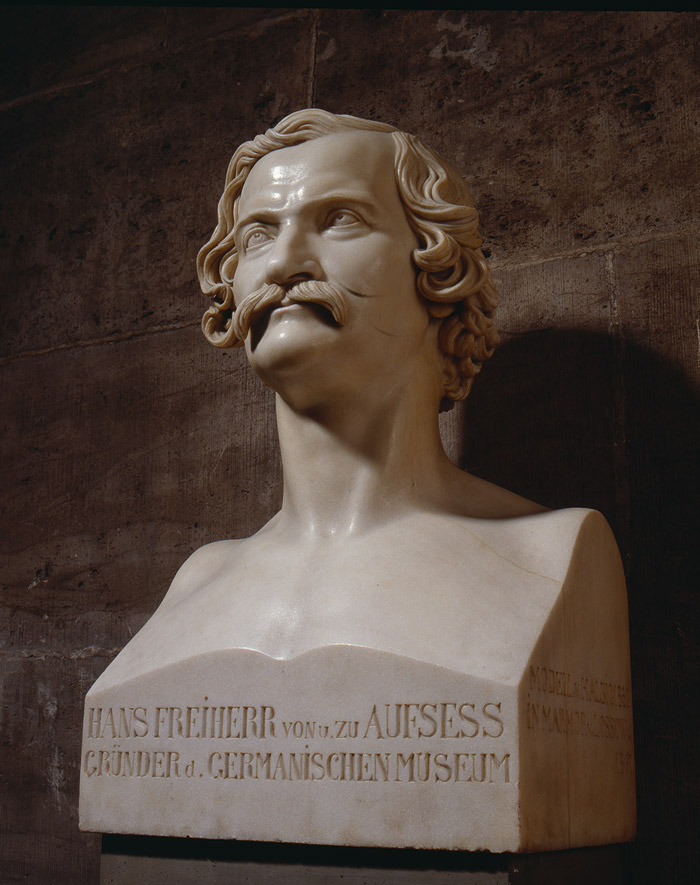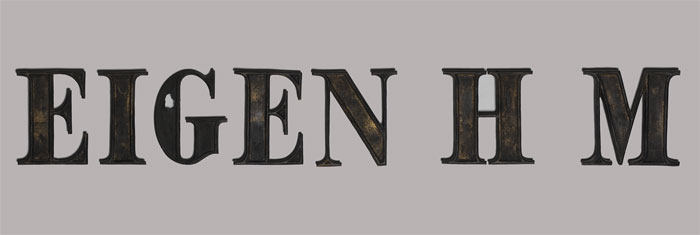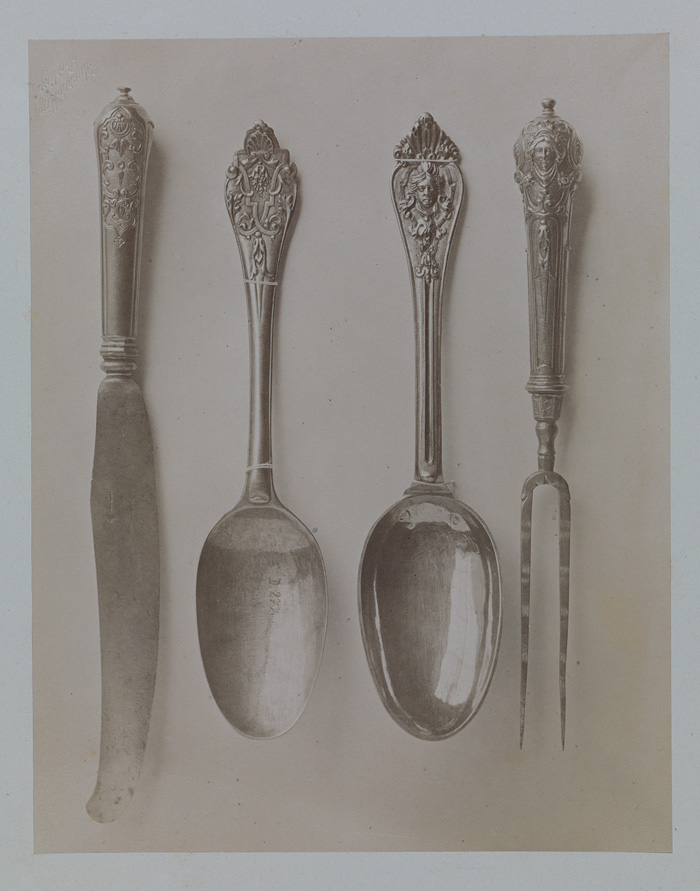The founding of the Germanisches Nationalmuseum

Project duration: 2006 – 2013/14
The historicizing architecture of the entrance lobby to the galleries, erected 1916-1920 after designs by German Bestelmeyer, provides the framework for the representation of the founding principle and the beginnings of the Germanisches Nationalmuseum whose main focus is the era Aufseß.
The juxtapositionof the visualisation of the now destroyed fresco The Opening of the Tomb of Charlemagne in Aachenby Otto III, by Wilhelm von Kaulbach,and Hans von Aufseß’ publication System der deutschen Geschichts- und Altertumskunde (“System of the German Study of History and Archaeology”) dominates the room. The painting, commissioned by Aufseß in 1859 for the Carthusian church, is the key to his patriotic ideas of a museum, visualizing in a programmatic history painting the exploration of national history for the glory of the German nation. His multi-paged, published “System” of the classification of the museum’s collections as well as the exhibited short version in the form of an organically grown genealogical tree express the same idea in words. The joining of the lofty image of the founding principle with its abstract concept points beyond the historical statement to the still valid conflict between scholarly abstraction and visual representation in museums.
Hans von Aufseß and the “Generalrepertorium”
An introductory sequence presents the founder of the museum, Hans, Freiherr von und zu Aufseß, selected incunabula of the early years and contemporary representations of the first exhibition galleries, since 1853 in the “Tiergärtnertor“ and since 1857 in the “Kartause“, the Nuremberg Charterhouse. This is followed by a thematic island with Aufseß’ vision of a general repertory (“Generalrepertorium”) and the installation of the early collections. The nucleus of the concept of Aufseß’ museum, founded 1852, consisted in the collecting and accessibility of “all source material for German history, literature and art, as for now, from the oldest times until 1650”. The exhibited catalogues, transcripts, reproductions and original works retrace the structure of this concept. Original and copy stood side by side as equals. Archival materials, works of art, literature and music as well as everyday objects were included. Already early on, reproductions were represented by photographs. This erudite collection was directed to the German people who through the study of German history were supposed to develop a national consciousness and identity. In scope, effort and expenditure of time, Aufseß compared his “national work” with the building of Cologne cathedral.
The Germanisches Nationalmuseum as “Property of the German Nation”
Contributions and donations from all circles of society were supposed to turn the Germanisches Nationalmuseum into the “property of the German nation”. Since 1859 this title could be read in golden letters at the gate, examples of which are shown in the exhibition alongside objects representing the whole social range of the donors from burgher to prince as well as the programmatic breadth of the donations, from art work to everyday object. As the first donor appears Hans von Aufseß himself whose private collection forms the nucleus of the museum. Especially closely associated with the foundation concept are nationally charged donations, such as the ramrod of the poet and freedom fighter Theodor Körner.
The Musealisation of the Revolution: The Legacy of 1848/49
After the end of the German Bund (German Confederation), the Germanisches Nationalmuseum took over the role of beneficiary and trustee of the “Greater German” (großdeutsch) solution: material artefacts of the first German Parliament in the Frankfurt Paulskirche and the German National Assembly were transferred to the museum in 1867. The sequential arrangement shows a selection of objects designated as “historical artefacts”, among them Philipp Veit’s Germania from the Paulskirche, an armchair from the assembly hall of the German Federal Assembly as well as several weapon models from the Department of the Imperial Navy, designed in 1848 for the construction of a German fleet.
Former Cafeteria
Following the exhibition galleries is an arcaded loggia which was glassed in 1970, transforming it to the first museum café in Germany. This area is going to be enlarged and furnished with modern media stations to house an information forum about today’s museum, thus forming a bridge from the historical knowledge storeroom of Aufseß’ “Generalrepertorium” to the up-to-date information centre for today’s museum visitor.
Team
Project management
Dr. Jutta Zander-Seidel
Dr. Ralf Schürer
Institute for Art Technology and Coservation (IKK)
Roland Damm, Dipl. Rest.
Annika Dix, Dipl. Rest.
Lisa Eckstein, Dipl. Rest.
Simone Hänisch
Frank Gerhard Heydecke
Ada Hinkel
Christiane Meinert, Dipl. Rest.
Martin Meyer, Dipl. Ing.
Susanne Rohm, Dipl. Rest.
Roland Schewe M.A.
Elisabeth Taube, Dipl. Rest.
Project team
Dr. Martin Baumeister
Dr. Yasmin Doosry
Dr. Daniel Hess
Dr. Frank M. Kammel
Anja Kregeloh M.A.
Dr. Petra Krutisch
Dr. Matthias Nuding
Dr. Ursula Peters
Dr. Markus Zepf
Exhibition design
Jürgen Wolff, Dipl.-Ing. (FH), Architekt
Lighting
Katrin Söncksen, lichttransfer, Berlin
WEITERE OBJEKTE DES FORSCHUNGSPROJEKTS

Information and Services
Plan Your Visit
Opening Times
Location and Approach
GNM Museum Shop
FAQ
Library
Branches
Contact


